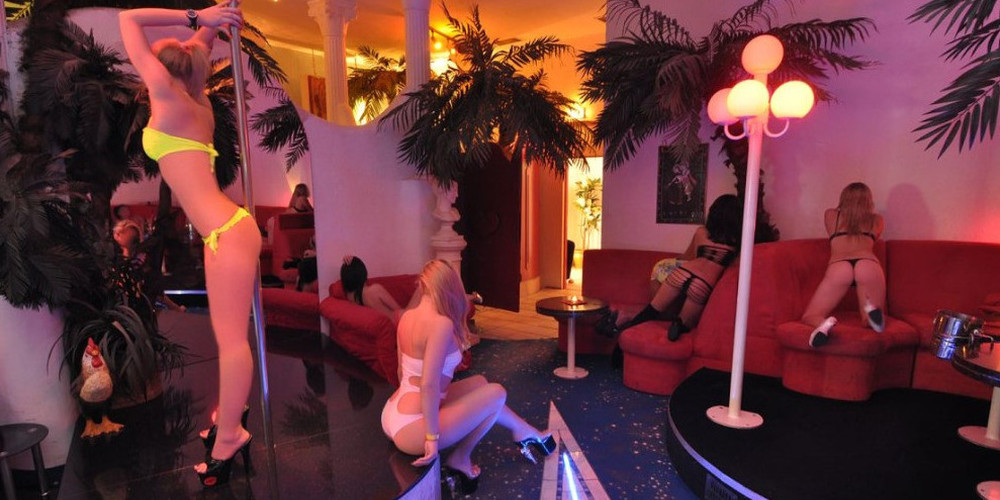
- Ja
- Kostenloses Essen
- Kostenlose Soft-Drinks
- Bier vom Fass
- Warmes Abendessen
- Behindertengerecht
- Blickgeschützter Parkplatz
- Kostenlose Parkplätze
- Außenanlage (Garten)
- Porno-Kino
- Whirlpool Indoor
- Swimmingpool Indoor
- Professionelle Massage
- Finnische Sauna
- Nein
- Kostenloses Bier
- Cocktails
- Sport-Live-Übertragung
- Kostenloses WLAN
- Klimatisiert
- EC-Automat / Zahlung
- SM Raum
- Spielautomaten vorhanden
- Übernachten möglich
- Whirlpool Outdoor
- Swimmingpool Outdoor
- Dampfbad
- Solarium
- Live Shows
- Live DJ
- Abholung möglich
- Wertfächer
Circa 6 Service-Zimmer.
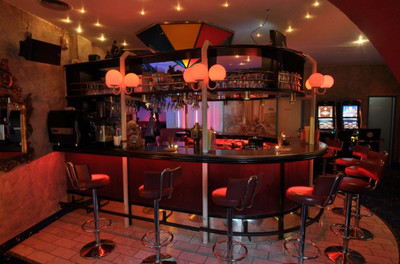
Die FKK Sudfass Oase in München-Pasing ist ein kleiner Saunaclub mit inzwischen langjähriger Tradition. Das Gebäude ist ein Flachbau mit etwas verwinkelter Innenarchitektur, der sich nach dem Betreten angesichts der zahlreichen Palmen und gemütlichen Kuschelecken als ausgesprochene Wohlfühloase erweist. Hauptaufenthaltsort ist der
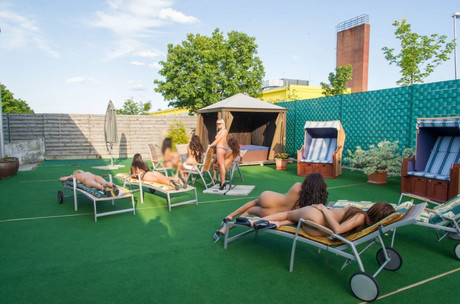
Barraum mit seinem bogenförmigen Tresen; dahinter befindet sich ein Whirlpool, der, von drei Deckensäulen eingefasst, auf einem Treppenpodest gekonnt in Szene gesetzt wird. Im Haus gibt es auch ein kleines Kino. Die Zimmer erweisen sich als geräumige und hochwertig dekorierte Liebeskammern. Außerdem gibt es noch ein sehr kompaktes
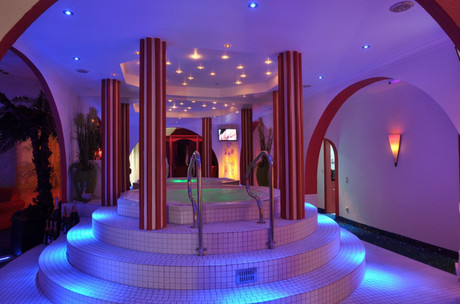
Freigelände. Die FKK Sudfass Oase ist ein echter FKK-Club; man sollte mit einem Line-up von etwa 10 Girls rechnen. Die Preisstrukturen sind im nationalen Vergleich wie bei allen Münchener Clubs überdurchschnittlich hoch. Da die Räumlichkeiten im Wesentlichen ebenerdig angesiedelt sind, ist der Club auch für körperlich Behinderte eine gute Wahl.
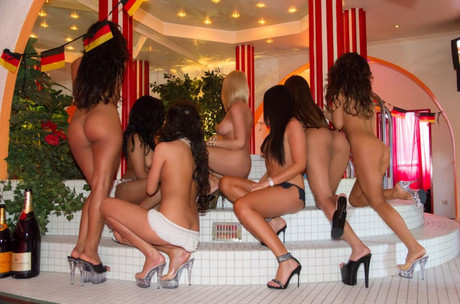
|
|
|
|
| ° | ° | ° |
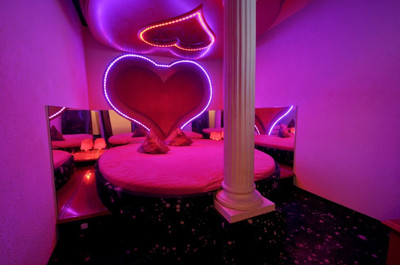
30min ab 60 EUR.
Line-up Range: Min |5-20| Max
München
Landeshauptstadt des Bundeslandes Bayern
Onomastik: forum apud Munichen (lat./ahd. munich=Mönch --> Platz bei den Mönchen)
erste urkundliche Erwähnung: 1158 n. Chr.
Einwohnerzahl: 1.488.000
Fläche: 310,70 km²
Regierungsbezirk: München
Landkreis: /
KFZ-Kennzeichen: M
Fluss: Isar, Würm
Der Club FKK Sudfass Oase befindet sich in München-Pasing-Obermenzing.
München ist in Bezug auf die Fläche als auch in puncto Einwohnerzahl die größte Stadt in Bayern. Nahe der Landeshauptstadt befindet sich der zweitgrößte Flughafen Deutschlands. Der internationale Airport (über A92 und S-Bahn-Linien S1 und S8 erreichbar) fertigt im Jahr nahezu 40 Millionen Passagiere ab. Per PKW kann München über die A8, A9, A92, A94, A95, A96 oder A99 angefahren werden.
An diverse Großstädte angebunden stellt auch der Schienenverkehr eine gute Option für Reisende dar. Mit Tram, U-Bahnen, zahlreichen Taxis sowie anderen Verkehrsmitteln verfügt München über ein sehr gut ausgebautes Verkehrsnetz, mit dem Sehenswürdigkeiten, öffentliche Einrichtungen usw. in München schnell und unkompliziert erreicht werden können. Verkehrsanbindungen bieten sich im Minutentakt an.
München ist gemütlich. München ist schön. München ist sauteuer. München ist eine Gaudi und zugleich eine einzige Pracht und außerdem total oberbayerisch, wenn auch auf ganz eigene Art, auf münchnerisch eben, eine Stadt, die ihre gewachsenen Traditionen stolz hervorzeigt und zugleich ein topmoderner, leistungsfähiger und auf Weltklasseniveau agierender Standort ist. Die Stadt belegt insbesondere in wirtschaftlicher, kultureller und politischer Hinsicht traditionell im deutschlandweiten Vergleich - wenn nicht weltweit - einen Spitzenplatz. Die Metropole ist eine der wirtschaftlich erfolgreichsten und am schnellsten wachsenden Europas. In der Städteplatzierung des Beratungsunternehmens Mercer belegte München im Jahr 2014 unter fünfzig Großstädten weltweit nach Infrastruktur den zweiten und nach Lebensqualität den vierten Platz. Im Zukunftsatlas 2016 belegen der Landkreis München und die kreisfreie Stadt München die Plätze 1 und 2 von 402 Landkreisen und kreisfreien Städten in Deutschland, sie zählen damit zu den Orten mit „Top Zukunftschancen“. Hier sind ein paar Schlaglichter zur Stadt:
München wurde 1158 erstmals urkundlich erwähnt. Die Stadt wurde 1255 bayerischer Herzogssitz, war von 1328 bis 1347 kaiserliche Residenzstadt und wurde 1506 alleinige Hauptstadt Bayerns. Gegen Ende des 18. Jahrhunderts wuchs München rapide, was 1806 noch beschleunigt wurde, als Bayern von Napoleon zum Königreich Bayern erhoben und München damit Hauptstadt eines doppelt so großen Landes wurde. Unter der Regierung von König Ludwig I. von Bayern (1825–1848) wurde München zu einer weithin bekannten Kunststadt. Die Klassizisten Leo von Klenze und Friedrich von Gärtner gestalteten die Ludwigstraße, den Königsplatz und die Erweiterung der Münchner Residenz. Der Sohn Ludwigs I, Max II., trat wie sein Vater als Bauherr hervor. Im neuen, an die englische Gotik erinnernden „Maximilianstil“ entstanden unter anderem die Bauten an der Maximilianstraße, heute eine der exklusivsten und teuersten Einkaufsstraßen des Kontinents. Unter Max II. Bruder Prinzregent Luitpold (1886–1912) erlebte München dann einen gewaltigen wirtschaftlichen und kulturellen Aufschwung. Es entstanden unter anderem die Prinzregentenstraße und das Prinzregententheater. Schwabing erlebte um die Jahrhundertwende eine Blüte als Künstlerviertel, in dem zahlreiche bedeutende Literaten und Maler der Zeit verkehrten. Der Blaue Reiter wurde 1911 ins Leben gerufen und ließ München schließlich zu einem Zentrum moderner Kunst aufsteigen. Mitglieder waren Paul Klee, Wassily Kandinsky, Alexej von Jawlensky, Gabriele Münter, Franz Marc, August Macke und Alfred Kubin. In den Folgejahren des I. Weltkrieges entwickelte sich München zunehmend zur Keimzelle nationalsozialistischer Aktivitäten. 1923 scheiterte in München der Hitlerputsch, der Marsch Hitlers auf die Feldherrnhalle München. Die Nationalsozialisten ehrten München später als die "Hauptstadt der Bewegung".
Der Marienplatz gilt als Mittelpunkt Münchens und liegt, umgeben von dem Neuen und dem Alten Rathaus, im Zentrum der Altstadt. Wenige Schritte davon entfernt liegt die Peterskirche, die älteste Kirche der Altstadt, deren erster Bau noch aus der Romanik stammte. Von der einstigen Stadtbefestigung stammen das Isartor, das Sendlinger Tor, das Karlstor und der Löwenturm am Rindermarkt. Die wichtigsten Profanbauten der Gotik sind der Alte Hof, das Alte Rathaus mit seinem Tanzsaal und das Zeughaus, das heute ein Teil des Stadtmuseums ist. Das in der Renaissancezeit umgebaute Weinstadl ist als eines der ältesten noch bestehenden Bürgerhäuser erhalten. Der um 1560 erbaute Eilleshof ist einer der letzten ursprünglich erhaltenen Altmünchner Laubenhöfe. Das 1589 gegründete Hofbräuhaus befindet sich heute in einem Bau des 19. Jahrhunderts am Platzl. Nach Norden Richtung Schwabing entstand die Ludwigstraße zwischen Feldherrnhalle und Siegestor. An ihr liegen die Bayerische Staatsbibliothek, die Ludwigskirche und die Ludwig-Maximilians-Universität sowie zahlreiche Staatsministerien. Ebenfalls zur Zeit Ludwigs I. entstanden die Theresienwiese sowie die dort errichtete Ruhmeshalle einschließlich der kolossalen Bronzestatue Bavaria.
Die älteste Gartenanlage ist der Hofgarten aus der Renaissancezeit mit dem Dianatempel. Nordöstlich schließen sich der Finanzgarten und der seit 1789 gestaltete Englische Garten an, der München vom Zentrum bis an die nördliche Stadtgrenze durchzieht, und mit 4,17 Quadratkilometern Fläche den Central Park in New York übertrifft. Der Schlosspark Nymphenburg entstand im Westen von Schloss Nymphenburg im französischen Stil. Im 19. Jahrhundert wurde er bis auf das „Grand Parterre“ in einen englischen Landschaftspark verwandelt. Nördlich schließt sich der Neue Botanische Garten an. Südöstlich von Nymphenburg liegt der ehemals kurfürstliche Hirschgarten. Gleich drei barocke Schlösser befinden sich an der nördlichen Stadtgrenze im Park von Schloss Schleißheim, neben Herrenhausen und Schwetzingen ist er der einzige erhaltene große Barockgarten in Deutschland.
Unter den modernen Bauten architektonisch am erwähnenswertesten sind der BMW-Vierzylinder am Olympiapark, neben dem im Oktober 2007 die futuristische BMW Welt eröffnet wurde, sowie das Hypo-Haus im Arabellapark und die im Norden von Schwabing gelegenen Highlight Towers. Das mit 146 Meter höchste Hochhaus der Stadt ist das Uptown München. Höchstes Bauwerk der Stadt ist der 291 Meter hohe Olympiaturm. Insbesondere nach der Jahrtausendwende wurden auch in München zahlreiche Hochhäuser gebaut, beispielsweise das 146 m hohe Hochhaus Uptown und die Zwillingstürme Highlight Towers, das 2008 fertiggestellte SV-Hochhaus oder der Skyline Tower. Seit einem Bürgerentscheid im Jahr 2004, in dem sich die Mehrheit der teilnehmenden Münchner Wähler gegen den Bau von Gebäuden mit einer Höhe von mehr als 100 Metern aussprach, wurde in der bayerischen Landeshauptstadt kein Hochhaus mehr errichtet, das die beiden einschließlich ihrer markanten Renaissancehauben knapp 99 Meter hohen Türme von Münchens Wahrzeichen, der 1488 errichteten Frauenkirche, überragt.
München ist international bekannt für seine Sammlungen der alten und klassischen Kunst, die in staatlichen, städtischen und privaten Museen wie Galerien präsentiert werden. So gehören zum Beispiel die Alte und die Neue Pinakothek sowie die Pinakothek der Moderne und das 2014 stark erweiterte Lenbachhaus zu den weltweit bedeutendsten Galerien. Zusammen mit der Glyptothek, den Staatlichen Antikensammlungen und dem Museum Brandhorst bilden diese Sammlungen das Kunstareal München. Auch das Staatliche Museum Ägyptischer Kunst erhielt einen Neubau im Kunstareal. Das Deutsche Museum mit weltweit einmaligen technischen Exponaten gehört mit über einer Million Besucher pro Jahr zu den meistbesuchten Museen Europas und ist das größte technisch-naturwissenschaftliche Museum der Welt.
München besitzt eine sehr reichhaltige Theater-, Ballett- und Opernkultur mit fünf staatlichen, drei städtischen und über fünfzig privaten Bühnen. Die Bayerische Staatsoper in München zählt zu den renommiertesten Opernhäusern der Welt und kann auf eine beachtliche Geschichte und Tradition zurückblicken. Europaweit beachtete Uraufführungen fanden bereits um 1700 statt. In der Sparte Sprechtheater sind die bedeutendsten Bühnen der Stadt das Bayerische Staatsschauspiel, die Münchner Kammerspiele und das Münchner Volkstheater.
Wirtschaft:
Wichtige Wirtschaftszweige in München sind Tourismus, Fahrzeug- und Maschinenbau, Elektrotechnik sowie Software- und IT-Industrie. Die hohe Dichte an IT-Unternehmen hat München auch den Spitznamen „Isar Valley“ eingebracht. München ist auch wichtiger Finanzstandort und das Versicherungszentrum Deutschlands. München ist Sitz zahlreicher Konzerne, darunter sieben DAX-Unternehmen (Allianz, BMW, Münchener Rück, Siemens, Infineon, Wirecard, MTU, bis 2018 auch Linde). Hier befindet sich die einzige Börse Bayerns. Als Medienstandort ist die Stadt von deutschlandweiter Bedeutung. In München haben weltweit nach New York die meisten Verlage ihren Sitz. Fernseh- und Filmindustrie sind in der Stadt und im unmittelbaren Umland stark vertreten (Fernsehindustrie in Unterföhring und Filmindustrie in Geiselgasteig). Mit der Constantin Film, der Bavaria Film und weiteren Unternehmen ist München auch eine der führenden Filmstädte. München ist Sitz des Bayerischen Rundfunks, der Programmdirektion des ARD-Gemeinschaftsprogramms Das Erste und des ZDF-Landesstudios Bayern. Ferner gibt es in München und im direkten Umland zahlreiche private Fernseh- und Hörfunkanbieter wie RTL II, ProSiebenSat.1 Media (ProSieben, Sat.1, kabel eins), Tele München Gruppe, Sport1, Sky Deutschland, München TV.
Das Oktoberfest ist der Welt größtes Volksfest und spielt der Stadt München innerhalb von zwei Wochen mehr Umsatz ein, als mancher Industriekonzern im Jahr erreicht.
München ist seit 1817 der Sitz des Erzbistums München und Freising, eine der reichsten Diözesen Deutschlands.
1846 kam die irische Tänzerin Lola Montez nach München und wurde die Geliebte des Königs Ludwig I. Sie erhielt eine luxuriöse Villa in der Barer Straße in München, einen Adelstitel (Gräfin von Landsfeld) und finanzielle Unterstützung von Ludwig. Die Affäre erregte europaweites Aufsehen. Am 20. März 1848 dankte Ludwig I. zugunsten seines erstgeborenen Sohnes Maximilian II. freiwillig ab.
Ludwig II. von Bayern (1845-1886) hat sich in der bayerischen Geschichte als leidenschaftlicher Schlossbauherr, vor allem der Schlösser Neuschwanstein, Herrenchiemsee und Linderhof, ein Denkmal gesetzt; er wird auch als Märchenkönig bezeichnet. Er regierte Bayern ab 1864. Nach seiner Entmündigung am 9. Juni 1886 übernahm sein Onkel Luitpold als Prinzregent die Regierungsgeschäfte im Königreich Bayern. Vier Tage später ertrank Ludwig II. im Würmsee (seit 1962 offiziell Starnberger See). Schloss Neuschwanstein ist eine der bekanntesten Sehenswürdigkeiten Deutschlands.
Franz Josef Strauß war wohl der streitbarste, brillanteste und durchtriebenste Politiker der deutschen Nachkriegsgeschichte. Er gehörte der Bundesregierung als Bundesminister für besondere Aufgaben (1953–1955), Bundesminister für Atomfragen (1955–1956), Bundesminister der Verteidigung (1956–1962) und Bundesminister der Finanzen (1966–1969) an. Von 1978 bis 1988 war er Bayerischer Ministerpräsident.
An durchschnittlich zehn Tagen im Jahr herrscht in München Föhn, ein warmer, trockener Fallwind vom Alpenhauptkamm, der so gute Fernsicht bewirkt, dass vom Stadtgebiet die Bayerischen Alpen deutlich zu sehen sind.
Italien ist nicht mehr weit von München entfernt und für ein verlängertes Wochenende schnell und gut erreichbar. In München gibt es insbesondere im gastronomischen Bereich eine umfangreich etablierte italienische Kultur im Stadtbild. Darum wird München auch gern als nördlichste Stadt Italiens bezeichnet.
Der FC Bayern München ist einer der erfolgreichsten Fußballvereine Europas. Er wurde am 27. Februar 1900 gegründet und ist mit rund 290.000 Mitgliedern) der mitgliederstärkste Sportverein der Welt.
Bekannte Söhne und Töchter Münchens sind etwa Ludwig II., Sissy, Richard Strauss, Karl Valentin, Lion Feuchtwanger, Franz Marc, Sophie Scholl, Christian Morgenstern, Carl Orff, Golo Mann, Franz Josef Strauß, Curd Jürgens, Beppo Brem, Gustl Bayrhammer, Walter Sedlmayr, Marianne Koch, Maxl Graf, Helmut Fischer, Heinrich Hugendubel, Peter Kraus, Robert Lembke, Werner Herzog, Rudolph Moshammer, Max Greger, Hugo Strasser, Fritz Wepper, Sascha Hehn, Horst Jüssen, Heidi Brühl, Chris Roberts, Michaela May, Rainer Erler, Suzanne von Borsody, Ute Willing, Olivia Pascal, Wolfgang Fierek, Georg Schwarzenbeck, Franz Beckenbauer, Uschi Obermaier, Konstantin Wecker, Jutta Speidel, Dominik Graf, Joseph Vilsmaier, Robert Havemann, Harry Valérien, Thomas Ohrner, Silvia Seidel, Jeanette Hain, Ralph Siegel, Giulia Siegel, Marianne Hartl, Franz Xaver Kroetz, Martina Gedeck, Marion Kracht, Alexander Held, Barbara Schöneberger, Nina Eichinger, Constanze Engelbrecht, Ulrich Noethen, Sonja Maischberger, Moritz Bleibtreu, Philipp Lahm, Michael Herbig, Maria Furtwängler und Harold Faltermeyer.
Hotel Imperial (1,0 Km)
Landsberger Straße 463
81241 München
https://hotelimperial.de
Hotel Villa am Schlosspark (1,1 Km)
Hieberplatz 3-5
81247 München
https://www.villa-am-schlosspark.de